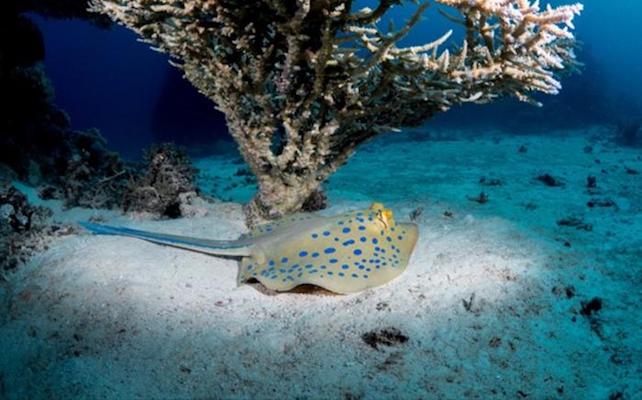ARTICLE AD
Bluespotted ribbontail rays create blue in a unique way, researchers report in a new study. Novel nanostructures give the stingrays their eponymous spots, the study shows, intricately contorting light on the rays' skin to form a vivid blue that doesn't change with viewing angle.
Blue is a tricky color for living things to conjure. Most shades in the natural world are produced by compounds that evolved to absorb sunlight and emit a particular color. In cases where red light is emitted, the chemical needs to absorb the more energetic wavelengths, of greens, blues, and violets.
Producing blue light typically requires absorbing low-energy red wavelengths and emitting the more powerful ones, a harder task that nature rarely finds solutions for.
A simpler solution, it seems, is to use another approach – scattering out the unwanted wavelengths using light-bending nanostructres in what is referred to as structural color.
"If you see blue in nature, you can almost be sure that it's made by tissue nanostructures, not pigment," says Mason Dean, associate professor of comparative anatomy at City University of Hong Kong and co-author of the new study.
These structural blues typically arise from highly ordered nano-architectures, yet the researchers' examination of these rays' blue spots revealed something different.
The structural blue is "unusually bright and angle-independent," they report, "arising from a more disordered array of scattering elements with a previously undescribed core-shell ultrastructure."
That alone would be interesting, but this discovery may also have practical applications for humanity, potentially inspiring new kinds of chemical-free colors.
Structural colors like this are complex natural phenomena, Dean points out, influenced by variables beyond how they bend light.
"Understanding animal structural color is not just about optical physics, but also the materials involved, how they're finely organized in the tissue, and how the color looks in the animal's environment," Dean says.
In this case, bluespotted ribbontail rays have regions of skin cells with special properties that help them produce this almost unearthly blue, explains lead author Amar Surapaneni, previously a postdoc with Dean's group and now a visiting academic at Trinity College Dublin.
 A bluespotted ribbontail ray in the wild. (Morgan Bennet Smith)
A bluespotted ribbontail ray in the wild. (Morgan Bennet Smith)"We discovered that the blue color is produced by unique skin cells, with a stable 3D arrangement of nanoscale spheres containing reflecting nanocrystals (like pearls suspended in a bubble tea)," Surapaneni says.
"Because the size of the nanostructures and their spacing are a useful multiple of the wavelength of blue light, they tend to reflect blue wavelengths specifically."
In addition to those blue-producing cells, the rays also have another trick that gives their blue an extra boost.
"To clean up any extraneous colors, a thick layer of melanin underneath the color-producing cells absorbs all other colors, resulting in extremely bright blue skin," Dean says.
"In the end, the two cell types are a great collaboration: The structural color cells hone in on the blue color, while the melanin pigment cells suppress other wavelengths, resulting in extremely bright blue skin."
The bluespotted ribbontail ray (Taeniura lymma) lives mainly in shallow waters around coral reefs in the tropical Indian and western Pacific oceans, with a range extending out as far as South Africa and Northern Australia.
It has potent venom, and its eye-catching coloration could have evolved as a warning. Nonetheless, it's generally timid around humans, typically fleeing rather than stinging when possible. And given the colors of its native habitat, blue may also help with camouflage.
"In water, blue penetrates deeper than any other color, helping animals blend with their surroundings," Dean says. "Bright blue skin spots of stingrays do not change with viewing angle; therefore, they might have specific advantages in camouflage as the animal is swimming or quickly maneuvering with undulating wings."
Borrowing some ideas from these rays might also yield benefits for our species, Dean adds.
"We are pursuing collaborations with fellow researchers to develop flexible biomimetic structurally colored systems inspired by the soft nature of stingray skin for safe, chemical-free colors in textiles, flexible displays, screens, and sensors," he says.
The study was published in Advanced Optical Materials.

 4 months ago
23
4 months ago
23 

